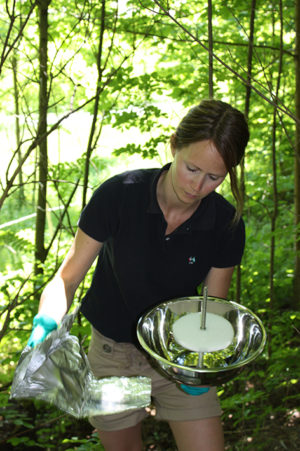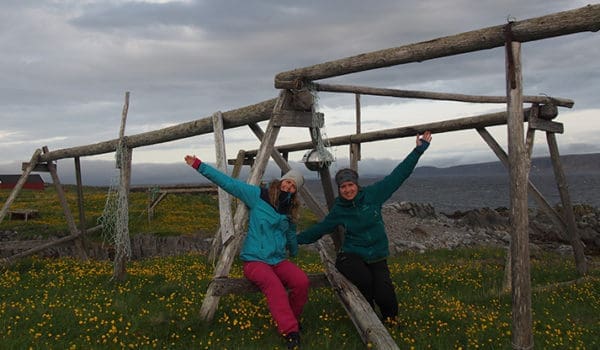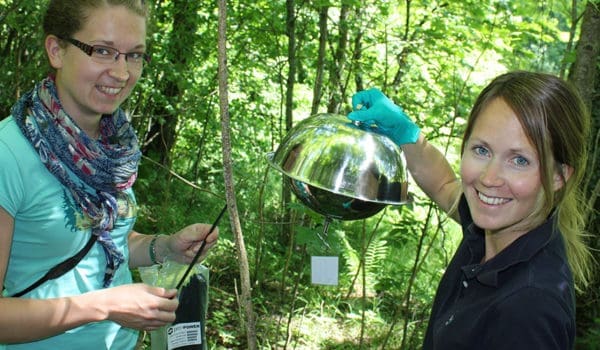From Fram Forum 2017: Environmental contaminants can travel with the wind from the equator to the Arctic, and the longer such contaminants survive in the environment, the greater their potential to cause unwanted effects on people, animals, and nature. Scientists from NILU have recently criss-crossed Norway, using “UFOs” to search for airborne organic contaminants.
In June 2016, PhD student Helene Lunder Halvorsen and scientist Ingjerd Sunde Krogseth from NILU – Norwegian Institute for Air Research got into a rental car proudly labelled with the NILU logo in Kirkenes, and embarked on a mission to deploy 55 air samplers throughout Norway. Three months later, they set out to collect them again.
Drifting through the air
The air samplers resemble UFOs; they are composed of two steel bowls, with a disc made of polyurethane foam in the middle. The disc acts as a filter, capturing semi-volatile organic compounds floating with the wind. The contaminants Helene and Ingjerd are particularly interested in capturing are known as POPs – persistent organic pollutants.

“POPs are a major global environmental problem”, explains Helene. This is partly because they break down very slowly in the environment (are persistent), accumulate in organisms (bioaccumulate), inflict damage on health and/or environment (are toxic), and can be transported over long distances. Examples of POPs are PCBs, various types of brominated flame-retardants, and pesticides like DDT.
“When these substances are released into the environment they can remain there for a long time”, continues Ingjerd. “In addition, they can travel with the wind, ocean currents and rivers, but transport by air is the fastest way POPs travel from their sources to more remote areas such as Norway and the Arctic.”
Environmental contaminants all over Norway
As long as the environmental contaminants remain in the air, they have little direct effect on animal and human health. However, once they are deposited on the ground or in the sea, they can be taken up by animals or fish and hence become part of the human food chain.
Not all sources of such contaminants are far away: some contaminants derive from local sources in Norway and the Nordic region. Helene wants to look into the relationship between the long-range transported contaminants and those from local sources during her doctoral work. This is knowledge that will benefit environmental authorities and policy makers when they consider whether local/national measures or international cooperation would be most effective to reduce the contaminant load.
The project is part of the programme Ecosystem effects – natural responses to changes in climate and the environment (ØKOSYSTEM), under the Research Council of Norway. In addition, a project funded by the Fram Centre’s Hazardous Substances flagship programme has facilitated deployment of UFOs to several places in Svalbard.
Not exactly lab conditions
Most of us think of scientists as white-clad people working in spotless laboratories.
“Not us”, laughs Ingjerd. “We obviously had to be very careful not to transfer chemicals from the car or ourselves while storing, wrapping or unwrapping samples and sampling equipment, but lab coats just would not cut it. Think rather nitrile gloves, rubber boots and raingear!”
The rental car was bursting with everything they needed to take and store samples of air, soil, and moss. All the foam filters were wrapped in aluminium foil and double plastic bags to avoid contamination, and the portable cooler was used for storing air samples rather than food.
“An extension cord for the cooler was a must”, Helene adds. “Without it, we would have had to sleep in the same room as the cooler at night, and it makes a lot more noise than you’d think!”
Other recommendations for their fellow scientists are to bring along both a GPS and coordinates, which should be checked at least twice for accuracy before leaving. Besides that, cameras, wipes, and mosquito hats are necessities – the latter because mosquito spray can contaminate the samples.
Piece of cake
The UFOs were left to collect contaminants from the air for three months, so in late September it was time for another road trip. This time they got help from senior scientist and project manager Knut Breivik. He started out in Kirkenes and stopped by NILU in Tromsø on the way before Ingjerd took over in Bodø. She drove through Trøndelag and the northwest of Norway down to Kjeller, where Helene took over. Crossing over the Stryne mountains to the west coast, she collected the UFOs along the coast to Egersund and then up to Kjeller again. The samples from Oslo and Svalbard were collected the week before.

“It was much easier to collect them than to deploy them”, says Ingjerd. “First, we had correct GPS coordinates for every sampler, and we did not have to spend time finding spots for the UFOs that were as representative as possible, and at the same time unlikely to be contaminated by human activity in the area. In addition, all the soil and moss samples had already been taken, so in comparison, this trip was a piece of cake.”
UFOs from all over Europe
All 55 UFOs on the Norwegian mainland were retrieved, and with few exceptions, they were all intact. Since the sampling is based on diffusion, the foam filter in the middle should under ideal conditions not be exposed to direct sunlight, rain or wind. However, in a few cases the lower bowl had slipped down so that the filter was visible. This may have affected the filter’s uptake and the sample’s validity. The same must be said about the sample from a UFO that had been almost completely filled by a wasps’ nest!
Besides collecting samples in Norway and Svalbard, Helene Lunder Halvorsen has completed a coordinated campaign in Europe. Altogether, she has sent out over 100 UFOs to air monitoring stations that are part of the European measurement network EMEP (European Monitoring and Evaluation Programme). All these have been returned by mail to NILU at Kjeller, where Helene and her colleagues have had their hands full sorting and storing the well-wrapped air samples in the freezer pending analysis in the laboratory.
“The analyses of samples from Europe will probably not be completed until after the summer”, says Helene. “Then I will process all the results and make a distribution map across Europe and Norway. When we are finished, we will know far more about what kinds of environmental contaminants are present in the air over Norway, and where they come from. Over time, this could contribute to more effective measures for preventing these substances from getting into the environment. In addition, we will use the results to evaluate a model that we are developing to simulate variations in concentrations of contaminants in both time and space, with special consideration of Norway and the Arctic. This will help us understand more about the sources and transport of environmental contaminants. It will also let us know what we don’t understand yet, and thus need to look into further.”

